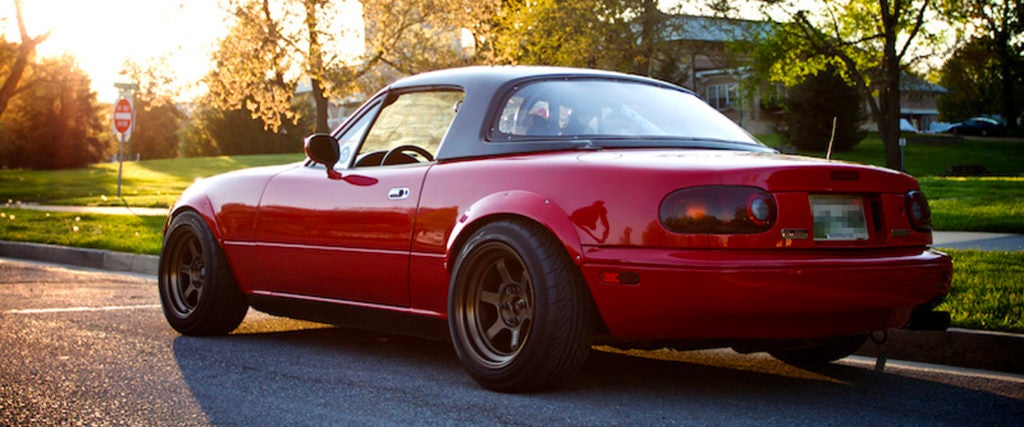About a decade ago, a friend in college let me borrow her car for a holiday weekend that I was spending alone in L.A. It was a 1999 Mazda Miata, with sun-stained crimson paint and a janky cloth convertible top that squeaked on the freeway.
With little to do and no one to see, I planned a day trip up to Malibu, about an hour’s drive from downtown L.A. I figured I’d park and spend the day reading and smoking a blunt on the beach. Instead, I ended up driving all afternoon, accelerating up the Pacific Coast Highway to Ventura and back, tossing the five-speed stick shift around and hearing the little four-cylinder engine scream through sweeping corners.
I can’t objectively say I was going anywhere fast that afternoon. But it sure felt like I was commanding a real race car, dancing along the coastal cliffs, blurring the line between man and machine.

For over 32 years, the Mazda Miata has maintained its reputation as one of the world’s great sports cars, with the newest 2022 model receiving mostly stellar reviews. To laymen’s ears, it might sound odd to speak of the Miata in the same breath as legendary cars from Ferrari, Lamborghini or BMW. The Miata’s petite appearance, minimal features and relatively low power compared to other “sports cars” has given it the misguided stereotype of being a “chick car.”
In a sense, I understand it. The historical iconography of American car culture naturally biases toward hetero dudes and cars that symbolize their own agency and power; heroes like Tony Stark and James Bond drive million-dollar supercars with 700 horsepower these days, not a four-cylinder Mazda that retails for 26k. Given that, it seems hard to imagine young, car-obsessed boys tearing down their Lamborghini posters in favor of a lil’ cherry Miata with pop-up lights.
And odds are, if you’re a dude who drives a Miata, someone in your life will wonder out loud: “Isn’t that kind of a girl’s car?” Indeed, you can find countless threads on car forums and Reddit with men wondering the same thing. Nevermind that trying to define a “girly” car is simultaneously offensive and unscientific, or that it bolsters a massive sexism problem in car culture, or just that manufacturers deliberately avoid gendered marketing. (Or even that Miata owners are literally, disproportionately men.)
But the Miata is the world’s best-selling sports car, ever — and nobody defends it better or more fiercely than the cult of men who adore them and spread the gospel, one snappy up-shift at a time. All it takes to be baptized is one formative experience behind the wheel. So it was with Travis Okulski, site director of Road & Track and a certified Miata nerd since he bought one as his first car in 2004, when he was 17.
“My dad had a Lotus Elan when I was growing up, which is one of the cars that inspired the Miata. So when I was looking for my first car, my dad said, ‘Why don’t you get a Miata?’ And basically how I felt at the time was that I didn’t want a small chick car, because there was a stereotype about the Miata. It took some convincing,” Okulski tells me. “But then I drove one, and it was the most fun I ever had in a car.”
The key to the Miata’s excellence is less about its features and more about what it doesn’t have. Yes, it runs on a tiny four-cylinder engine, but the Miata weighs hardly anything at all (just around 2,300 pounds — a thousand pounds lighter than your average sedan). Yes, its engineering is minimalist in nature — making it dead reliable, saving weight and cost and allowing owners to modify their vehicles freely. No, it doesn’t have much in the way of technology or luxury amenities — because you’re supposed to be feeling the road and flooring it, not fiddling with climate controls or autopilot.
Okulski’s first Miata was a pristine 1996 model with blue paint, which he spent a decade adding modifications to for autocross racing. Despite his customizations, however, the car’s nimble, happy-go-lucky spirit always shined through. “By 2004, cars were getting so fast that you couldn’t have any fun on the road. You hit second or third gear, and you’re going at speeds that will get you arrested. That’s not the case with a Miata. The car emphasizes fun over numbers, which I find really important,” Okulski observes. “It communicates with you. The way the steering feels, with every imperfection on the road coming through your hands… It makes you want to drive.”
That focus in purpose has remained true over two decades, a feat that impresses Patrick George, editorial director of Recurrent Ventures’ automotive and military publications, including The Drive and Car Bibles (and also the new owners of MEL). He doesn’t own a Miata, but he’s driven them many, many times and remains an advocate for the car and the consistency of its essential character over the years.
“Thanks to federal safety regulations and buyer preferences, cars have only gotten bigger and heavier over the last 30 years. It’s pretty miraculous that Mazda has been able to not go down that path and screw up the Miata,” George tells me. “It took deliberate action to preserve it. It’s impressive for a small independent Japanese car company that doesn’t have a manufacturing base in the U.S.”
For all those reasons, repping a Miata feels like a countercultural experience, at least compared to what popular culture imagines the ultimate “sports car” to look and sound like. I especially love the gentle curves, pop-up lights and grinning bumper of the original “NA” Miatas, built from 1989 to 1997. But no matter the generation, Miata enthusiasts can find a subculture of like-minded drivers, full of support and a million tips. “You didn’t get it until you got in the car. I didn’t get it before I owned one, either. I think people who ‘get it’ really relish the opportunity to convert others who may be questioning why this car exists,” Okulski points out.
I think about buying a Miata all the time these days. Since the pandemic, I’ve basically had very few reasons to need a car; I said goodbye to my old, money-draining BMW sedan in 2020 before moving to Northern California. Amid the existential crises of economic destruction, climate change and the unceasing march of time, I’ve realized that a fuel-efficient convertible that can (somehow, improbaby) tow a small trailer and haul Ikea furniture, but also let me have the time of my life on a mountain road, is about as good as it gets. I think of the message I got on Twitter from Michael Gagliardi, a former Miata owner who noted that “the simple fucking joy of driving a go-kart to work everyday was unmatched” despite how impractical using a two-seat roadster as a daily driver can be.
“It makes driving a Miata an act of defiance, a singular fuck-you to the world and a signal that you care solely about having some fun in your life, before capitalism or a lifted pickup truck literally crushes it out of you,” Gagliardi, who is in the market for a new Miata, tells me.
Maybe that’s why I’m so attracted to the Miata — there’s something subversive about it in a car landscape still dominated by hetero-bro “size matters” energy. So what if the Miata still has less power than a Toyota Camry? As George points out, Americans are obsessed with muscle-car power and straight-line speed as the barometer for sports-car “fun.”
The Miata is effectively allergic to that mindset, and the tired one-upmanship that comes with it. “It just wants to give you a great time behind the wheel,” George says. “No matter where you are.”
Maybe that’s why the cult of Miata likes to joke that the little car’s name is secretly an acronym that stands for “Miata Is Always The Answer” — no matter which model you drive, and no matter what gender you are.

